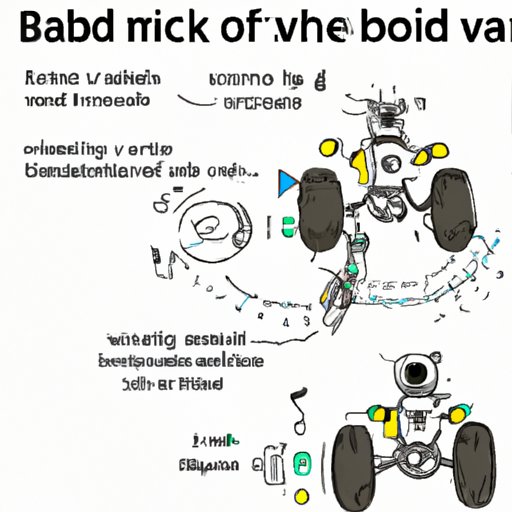Introduction
Robots are machines that are programmed to perform specific tasks autonomously or semi-autonomously. They can be used in a variety of applications, from manufacturing to military operations. But in order for robots to be effective, they need to be able to move around their environment. This article will explore how robots move, examining the different types of robot movement, the mechanics behind robotic mobility, and how robots navigate their environment.
Exploring the Different Types of Robot Movement
Robots can move in many different ways, depending on the task they are designed to do. The most common type of robot movement is wheeled motion. Wheeled robots use two or more wheels to move around, and can be controlled by a remote or programmed to move autonomously. These robots are often used in industrial settings, such as factories, where they can move quickly and efficiently.
Another type of robot movement is legged motion. Legged robots have legs instead of wheels, which allows them to traverse rough terrain such as stairs or hills. These robots are often used in search and rescue operations, where they can access areas that are difficult for humans to reach.
The third type of robot movement is aerial motion. Aerial robots, also known as drones, are equipped with propellers or jet engines that allow them to fly. These robots can be used in military operations or surveillance, as they can cover large distances quickly and with minimal noise.

Examining the Mechanics Behind Robotic Mobility
In order for robots to move, they need to have certain components in place. The most important component is a motor, which is used to turn the wheels or legs of the robot. Motors come in various sizes and types, each with its own advantages and disadvantages.
In addition to the motor, robots also need gears and sensors. Gears are used to transfer power from the motor to the wheels or legs of the robot, while sensors are used to detect obstacles or changes in the environment. Together, these components allow robots to move around their environment.

Investigating How Robots Navigate Their Environment
In addition to being able to move around, robots also need to be able to navigate their environment. This is done through path planning algorithms, which tell the robot which path to take in order to reach its destination. Path planning algorithms take into account the robot’s current position, the goal position, and any obstacles that may be in the way.
Robots also use computer vision to help them navigate their environment. Computer vision uses cameras and image processing algorithms to detect objects and changes in the environment. This information can then be used to plan routes and avoid obstacles.
Finally, robots use obstacle avoidance algorithms to detect and avoid obstacles in their path. These algorithms use data from sensors, such as sonar or infrared, to detect obstacles and calculate an alternate route around them.

Analyzing the Advantages and Disadvantages of Robot Motion
Robot motion has both advantages and disadvantages. One advantage is speed; robots can move faster than humans, allowing them to cover large distances quickly. Another advantage is maneuverability; robots can navigate tight spaces and turn corners easily. Finally, robots are more durable than humans; they can operate in hazardous environments without risking injury.
On the other hand, robots have some drawbacks. They are limited in terms of strength and endurance; they cannot carry heavy loads or work for long periods of time without needing to be recharged. Additionally, robots are not as accurate as humans; they are unable to make decisions based on intuition or experience.
Understanding the Different Types of Motors Used in Robots
There are three main types of motors used in robots: servo motors, stepper motors, and DC motors. Servo motors are used to move parts of the robot with precision, such as arms or legs. Stepper motors are used to move the wheels of the robot, as they can turn in small increments. Finally, DC motors are used to provide continuous power to the robot.
Comparing Human and Robot Movement Capabilities
Robots and humans have different strengths and weaknesses when it comes to movement. Humans are stronger than robots; they can lift heavier objects and carry them over longer distances. Additionally, humans have greater endurance; they can work for long periods of time without needing to rest. Finally, humans are more accurate; they can make decisions based on past experiences or intuition.
In comparison, robots are faster and more maneuverable than humans. They can move quickly and accurately, and can navigate tight spaces with ease. Additionally, robots are more durable than humans; they can operate in hazardous environments without risking injury.
Conclusion
In conclusion, this article has explored how robots move and navigate their environment. It has examined the different types of robot movement, the mechanics behind robotic mobility, and how robots navigate their environment. Additionally, it has discussed the advantages and disadvantages of robot motion, the different types of motors used in robots, and a comparison between human and robot movement capabilities. Through this exploration, it is clear that robots are capable of impressive feats of locomotion, making them invaluable tools in many different fields.
(Note: Is this article not meeting your expectations? Do you have knowledge or insights to share? Unlock new opportunities and expand your reach by joining our authors team. Click Registration to join us and share your expertise with our readers.)
